12 low-light indoor plants for shady spots in your home
If you’re looking for low-light indoor plants that will thrive in dark or gloomy spots our experts have the solutions
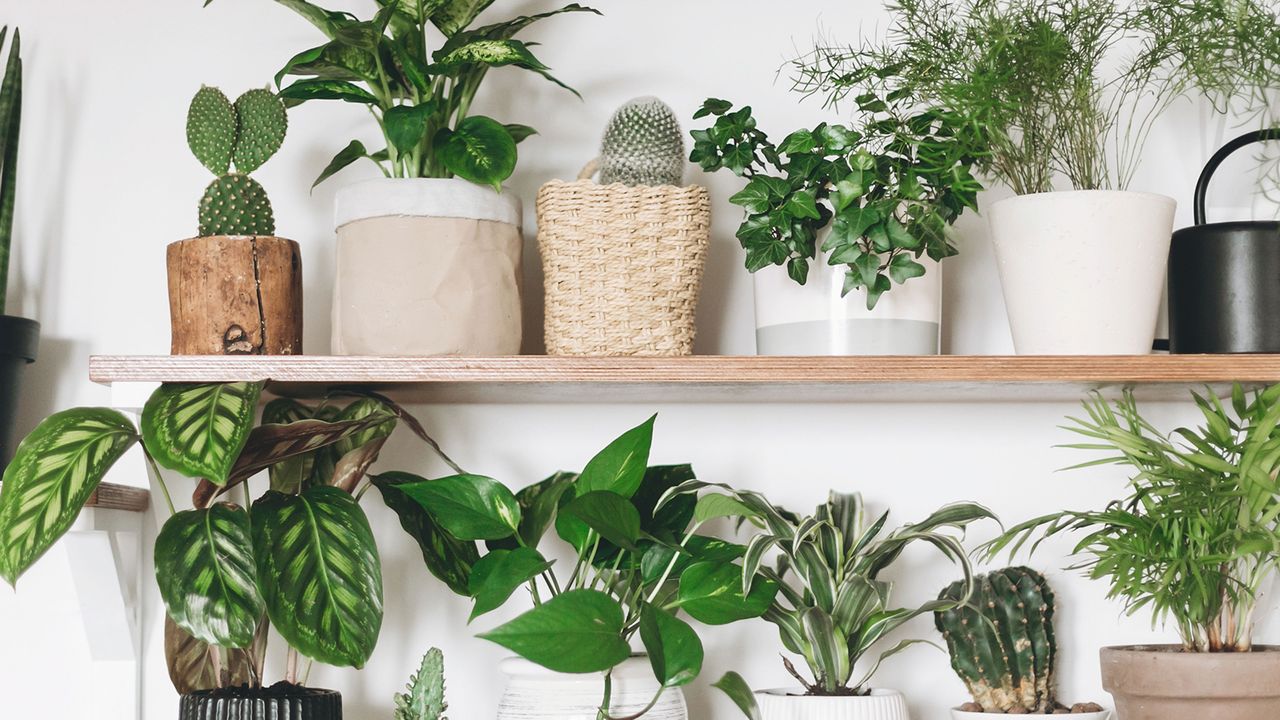

There are plenty of low-light indoor plants that will work for dim rooms and gloomy hallways that aren’t flooded with natural light. It means dark and shady corners or windowless spaces in your home can still be filled with greenery to brighten up your interior on even the most overcast days.
With a lack of bright, natural light, even the best indoor plants can find it difficult to flourish, especially during the winter months when our homes tend to be a little darker due to the lack of bright light during the colder months. Plants can therefore start to look limp and lacklustre as they struggle to thrive.
‘Making sure your plants have enough light is an essential part of plant care, however some indoor plants can still happily live on the shadier side,’ says Jo Lambell of Beards & Daisies. ‘In fact, some even prefer darker conditions. If you’re looking to fill that spot in a dark hallway, or have a north-facing bedroom, there’s always a solution that will thrive where other plants may struggle.’
Brighten a dark spot with low-light indoor plants
‘Think all plants need sun to thrive and survive? Wrong! There are actually lots of houseplants that love a little more shade,’ says James Folger, founder of The Stem.
Our choice of low-light indoor plants will give even the shadiest of indoor garden ideas a boost.
1. Asparagus fern
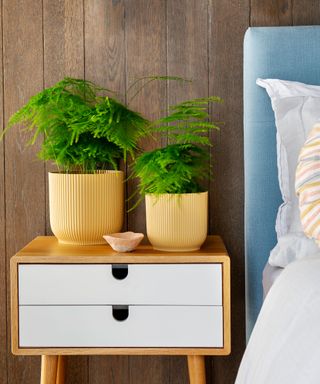
With its feathery rich green foliage asparagus is an easy plant to grow in shaded conditions indoors. In the wild, the asparagus fern grows beneath trees, which means it’s used to shaded light, making it the perfect choice for homes with low light levels and dark corners.
‘Don’t let the name confuse you though, this plant isn’t a true fern,’ says Jo Lambell of Beards & Daisies, 'it’s just nicknamed this in reference to its wispy fronds. It’s actually a relative of lilies.’
Choose a spot in indirect light and keep the compost moist as once established asparagus ferns do need a lot of water. But be careful as too little light could cause the plant to go yellow and shed its needles.
Keep them moist throughout the growing season, reducing how much you water them from late autumn to late winter. Misting their foliage in winter is beneficial too, especially if they're in a spot near a radiator.
There are plenty more tips on how to care for houseplants in winter in our guide too.
2. Philodendron Scandens
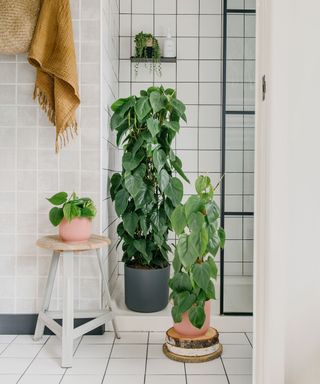
The Philodendron Scandens is a climbing or trailing plant with aerial roots, light green heart-shaped leaves and the common name ‘Sweetheart Plant’. It has a very easy nature, and adapts seamlessly to both home and office environments.
These plants come from deep in the interior of the rainforest where they thrive in humid, very warm conditions in the deep shade of the tree canopy where they flourish in filtered, dappled light. This means they're one of the best plants for bathrooms too as they will thrive in the steamy atmosphere.
‘There are 489 different species of Philodendron – serious plant goals to own them all,’ says Jo Lambell of Beards & Daisies. ‘The Scandens variety is a super hardy and easy to care for houseplant. It will benefit from an occasional dusting to keep the pores open. Keep it in your bedroom and let it trail down from a shelf.’
This plant will be happy in a low-light room as long as its heat and humidity requirements are met. Ideal temperatures are around 60–70˚F (15–21˚C).
3. Peace lily
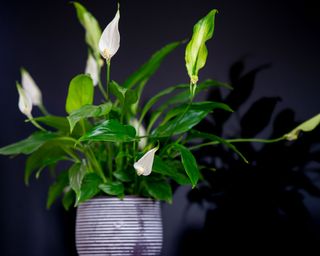
‘With its glossy deep green leaves the peace lily is one of the best low light indoor plants,’ says James Folger of The Stem. ‘It just grows and grows and is so calming, adding lushness to create a tranquil space. Native to the steamy jungles of Bolivia, peace lilies will thrive in light shade and high humidity, so they’re perfect for the bathroom.'
Peace lilies do well in the shade and can also tolerate fluorescent lights, making them a good choice for the office too. Providing you follow peace lily care tips, they will do well in your home during winter, and when the light gets better they can be transferred to a windowsill, although not in the full glare of the sun as it may scorch the leaves.
4. Spider plant
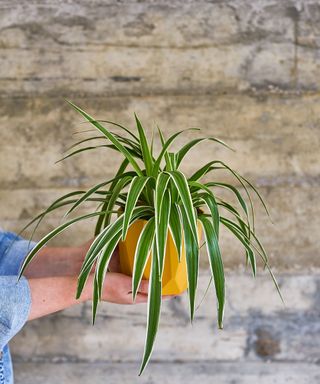
Caring for a spider plant is a cinch as it's one of the easiest houseplants around. They trail really well so they are ideal for shelves or indoor hanging planters. As the plant gets older it will start to produce upward-facing stems of white star-shaped flowers and lots of babies.
‘The spider plant has distinctive variegated foliage that resembles long blades of grass,' says Jo Lambell of Beards & Daisies. 'This is a very easy care plant and is tough enough to withstand low light spots.’
Spider plants prefer shadier conditions. It will also grow in bright light but this tends to make the leaves look pale and bleached out and full glare will damage the variegated leaves.
Spider plant propagation is a really easy way to grow your houseplant collection and get extra plants for free, too.
5. Aspidistra
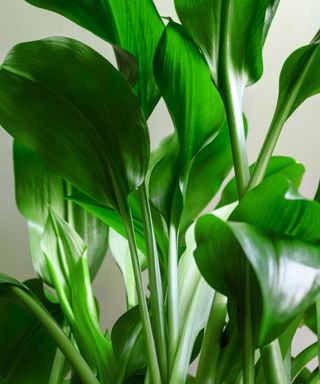
Perfect for indoor plant ideas, the aspidistra will tolerate any environment and is comfortable with being in the shade, fluctuating temperatures, dry atmospheres and infrequent watering. Their preferred spot is light shade and it’s a very good houseplant for cold, dark rooms.
Another name for the aspidistra is ‘cast iron plant’ because they are impossible to kill, which is why they are also one of the best low maintenance indoor plants. They were popular in the Victorian times as houses tended to be dark inside and aspidistra were still able to grow successfully.
The leaves are lush so to prevent the tips from going brown simply mist them every few days. Although it enjoys a little summer sunshine don’t place your aspidristra in direct sunlight as this can burn the leaves.
6. Calathea
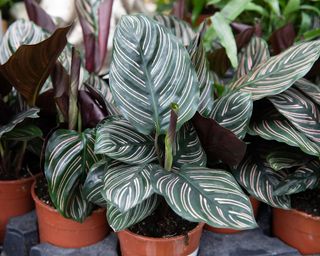
This striking plant has beautiful shades of green, lilac, cream and purple on its leaves. It originates from the tropical rainforests of South America so it will thrive in a shady and humid spot. It’s a speedy grower too.
They are best grown in shade or indirect light, just like prayer plants which they're often confused with as the patterning on their leaves is very similar. Direct sunlight will fade its distinctive leaf markings. You do need to water it frequently though as the soil needs to be moist, and it doesn’t like being placed near drafts.
These plants are truly adapted to thrive in very filtered, dingy conditions. Calathea also like warm rooms, 60˚F (16˚C) and above.
7. Satin Pothos
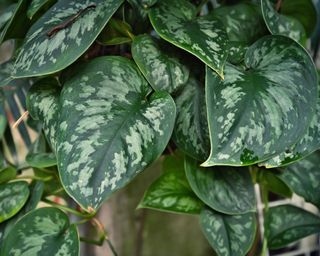
Originating from South Africa, this little beauty loves low light and is easy to grow. The silver variegation on the leaves is unusual and as this plant grows it will start to trail down, making it a good choice for all you #shelfie fans out there.
It's a good choice too if you tend to forget to water your plants, as this variety only needs a weekly water and you can allow the soil to go dry too.
‘Whichever room you place these in will be transformed into a lush tropical paradise,’ says James Folger. ‘Just what we need during the darker winter months.’
Also known as devil’s ivy, pathos has earned a reputation for being impossible to kill, and it is very tough. The vines can be grown in low light levels and hot sun may scorch the leaves.
8. ZZ plant
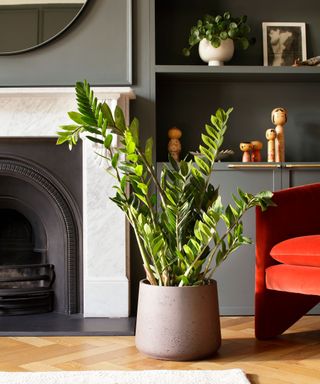
Newly popular thanks to a million fans of its foliage on Instagram, the ZZ plant is having a moment. The abbreviation ZZ stands for Zamioculcas zamiifolia, a plant that is so accepting of lack of light it could easily be top of the low-light indoor plants list. It actually helps to brighten rooms too as its leaves have reflective qualities.
‘The ZZ plant is incredibly laidback and requires very little care. It doesn't need too much water or light to survive, hence the praise for being so hardy. In fact, we’d say it’s virtually unkillable and the perfect plant for beginners,’ says Jo Lambell.
‘This plant works particularly well in the bedroom,’ says James Folger. Having plants around me when I wake up puts me in a great mood for the day, especially if it's a bit drizzly outside. It’s one of the most eye-catching plants and I love the waxy, deep green, oval-shaped leaves, attached to its elegant, arching stems.’
It looks particularly good partnered with Swiss cheese plants which also have dark glossy leaves and are super low-maintenance.
9. Kentia palm (parlour palm)
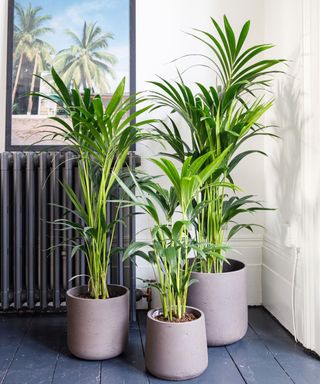
In the Victorian era the Kentia palm was known as the parlour palm because most sitting rooms had one. Known for being dark and gloomy spaces, the fact the Kentia palm not only survived here but thrived tells us all we need to know about it being one of the best low-light indoor plants.
‘This tropical plant is still as popular now as it was almost 150 years ago,’ says Jo Lambell. ‘The Victorians loved it and so do we. Known for its long stems and lush green, feathery foliage, the Kentia palm is native to the rainforests of Southern Mexico, so has the ability to adapt to relatively low light and low temperatures. In other words, it’s another plant that’ll breeze life in the shade.'
Kentia palms can grow in low, indirect light in a north-facing room, but do better with a little more light. They can be grown in full sun but you will have to water them far more regularly. You can ease off watering in winter, when light levels drop off, but again, don’t let the plant completely dry out for an extended period of time. It looks great in a hallway and is good on a desk, so it's a great choice to style up a home office that might be a bit shadier.
'The Kentia palm is a stunning indoor palm tree,' says James Folger of The Stem. 'It's a great way to bring a lush, exotic vibe to your home. Kentia palms are hardy plants that can tolerate some neglect, (but not too much!) and are a great choice for low-light spots.'
10. Snake plant
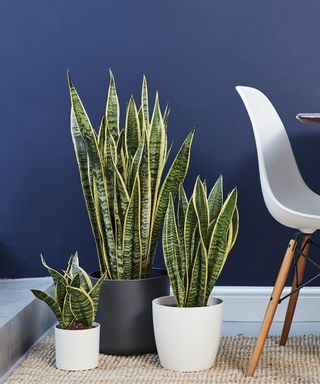
The striking blade-like shape of snake plant leaves makes them quite the statement in a room. These plants are extremely easy to look after, experts at purifying the air, and best of all can tolerate low light conditions.
Its laidback nature and easy disposition is key to its recent surge in popularity. ‘The snake plant isn’t too fussy or particular about where it's homed,’ says Jo Lambell. ‘Access to bright, indirect light is best, but it can tolerate shadier spots, too. It's one of the best plants for bedrooms as it’s a fantastic air purifier, removing toxins such as formaldehyde and benzene from the home.’
11. Hare foot fern
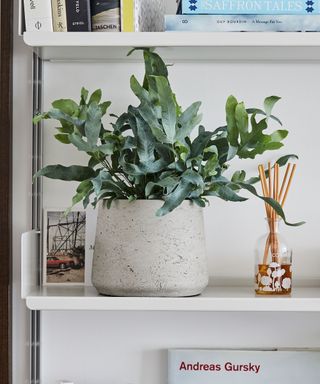
Blue star fern (hare foot fern) from Patch Plants
The hare foot fern is a tender, evergreen fern that's a popular option for the low-light indoor plants. Its blue-green foliage is stunning and it's easy to grow and you can even move it outdoors in the summer.
In addition to hare foot fern, it's known by lots of other names - Phlebodium aureum, golden polypody, golden serpent fern, cabbage palm fern, gold-foot fern and blue-star fern.
‘My favourite low light plant is Phlebodium aureum,’ says Patch Plants Plant Doctor Richard Cheshire. ‘It has faint and smoky blue tint to the leaves. I find it super rewarding as it produces lush growth in the shady corners of my home where other plants thrive less well.’
Preferring an east- or north-facing room and varying degrees of shade, for best results, grow the hare foot fern in a bright spot out of any direct sunlight, in moist, well-drained soil.
Keep a spray bottle handy so you can give it a regular misting to raise the humidity, or alternatively try growing it in a bright, steamy bathroom where it will thrive in the humid environment, just like an orchid will.
12. English ivy
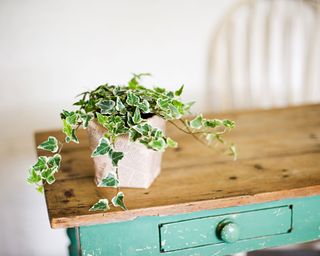
English ivy (also known as Hedera) grows easily and is one of the best indoor hanging plants. It will cope with low light, has beautiful variegated leaves and looks stunning if you let it trail, hang or climb.
'Ivy is also known as an air-purifying superstar and can live indoors or outdoors,' says James Folger of The Stem. 'It looks equally as lovely on a shelf or in a hanging pot, but watch out, it can grow very quickly.'
Regular pruning will help keep it in great condition. The leaves are a stunning shape, and due to the variegation, completely unique. 'I have mine in a north-facing bedroom in my home,' says James. 'It is slightly cooler, which the ivy loves.'
What is considered low light for indoor plants?
If you put your plant in a low-light position it means no direct sunlight will reach its leaves. This means it is probably a few feet away from a window or any other access to the outside light such as doorways or skylights.
Low light means less energy and less food for your plant, however, ferns, ZZ plants, Philodendron and plenty of other low-light indoor plants all love conditions like this as they are used to be shaded from light because they originate from the forest floor.
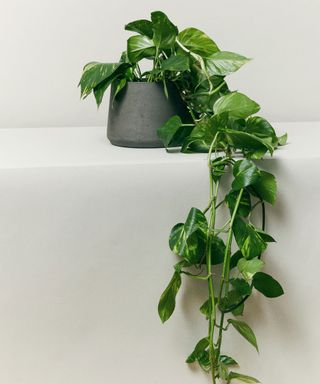
What plants will grow in a windowless room?
If there's a windowless room in your home such as a bathroom which means there's no natural light, or maybe you work in an office with fluorescent lights only, there is a choice of low-light indoor plants to choose from such as snake plants, aspidistras, peace lilies and philodendrons.
You can also add artificial grow lights to help stimulate photosynthesis when natural light is not an option. There are several different types of grow lights available. Choose from fluorescent lights (CFL), high-pressure sodium lights (HPS) or light-emitting diodes (LED), all are available on Amazon.

Snake plants including the cylindrical variety from The Stem
Tips for finding the best spot for low-light indoor plants
It's important to remember that just because your houseplant is a shade loving plant, it doesn’t mean you can forget about it entirely. All plants need at least a little bit of light to survive.
As levels dip in the darker months, the ledges of south-facing windows that are normally too bright for many indoor plants in the summer are just right in winter, so it's a good idea to move plants around until you find the ideal conditions for growth.
‘Check the positioning of your plants in relation to the sun,’ suggests Jamie Folger. ‘In winter, light comes into the home at completely different angles. This means that spots you thought were shady might actually be getting a lot more sun than you thought. West-facing windows might suddenly be getting a full day of sun now, and south-facing spots might suddenly become a lot shadier. If your plant can get a little sun during the day, all the better.’
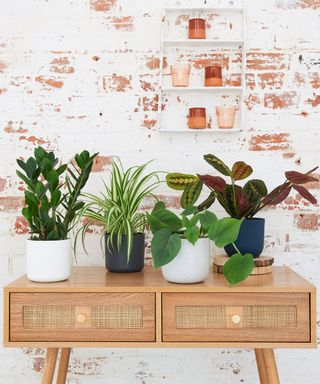
A selection of low light indoor plants known as the Shade Bundle from Beards & Daisies including (from left): ZZ plant, spider plant, Philodendron Scandens and prayer plant

Lifestyle journalist Sarah Wilson has been writing about gardens since 2015. She's written for Gardeningetc.com, Livingetc, Homes & Gardens, Easy Gardens and Modern Gardens magazines. Having studied introductory garden and landscape design, she is currently putting the skills learned to good use in her own space where the dream is establishing a cutting garden.
-
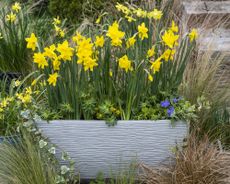 An Update on Gardeningetc
An Update on GardeningetcA word from our publisher
By Beth Murton Published
-
 Do you need to chit potatoes? Find out what the experts say
Do you need to chit potatoes? Find out what the experts sayGrow Your Own Learn how to chit potatoes before planting them in the ground and you’ll be on your way to getting an earlier and bigger harvest
By Drew Swainston Published
